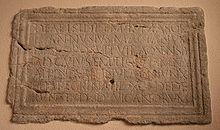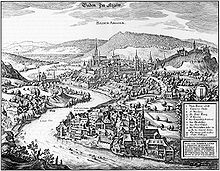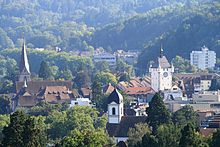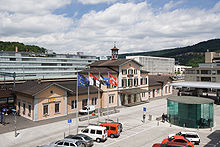- Baden, Switzerland
-
Baden Country Switzerland 
DetailsCanton Aargau District Baden 47°28′N 8°18′E / 47.467°N 8.3°ECoordinates: 47°28′N 8°18′E / 47.467°N 8.3°E Population 18,059 (Dec 2010)[1] - Density 1,371 /km2 (3,551 /sq mi) Area 13.17 km2 (5.08 sq mi) Elevation 381 m (1,250 ft) Postal code 5400 SFOS number 4021 Mayor (list) Stephan Attiger (as of 2008) FDP/PRD Surrounded by Birmenstorf, Ennetbaden, Fislisbach, Gebenstorf, Mellingen, Neuenhof, Obersiggenthal, Turgi, Wettingen Twin towns Sighisoara (Romania) Website www.baden.ch
SFSO statisticsView map of Baden Baden is a municipality in the Swiss canton of Aargau, on the west bank of the river Limmat, located in the Limmat Valley (German: Limmattal), 25 km (16 mi) northwest of Zürich. It is the seat of the district of Baden. The name refers to the mineral hot springs, which were known at least as far back as the Roman era.
Its population in 2010 was over 18,000.
Contents
History
Baden was known to the Romans as Aquae Helveticae. In 1040 the town is first mentioned as Baden.[2]
Aquae Helveticae was first mentioned by Roman historian Tacitus. At that time it was a Roman Vicus to the north of the Baden gorge on the Haselfeld. On the left bank of the Limmat bend there was a pool complex, which was fed by the 47 °C (117 °F) water from a system of springs. The Vicus was founded to support the establishment of the legionary camp at Vindonissa. Both the spa quarter and the residential and commercial district grew to a respectable size in the first half of the first Century AD. The town suffered a setback in 69 AD as members of the XXI Legion burned the wooden buildings of the vicus during the Year of the Four Emperors. The town was rebuilt in stone. When the legion camp at Vindonissa closed in 101 AD, the town shrank again slightly. Although the prosperity of the local spas diminished, the town survived on trade. The pottery workshop of Reginus and the bronze works of Gemellianus flourished in the second half of the 2nd Century. The multiple Alemanni invasions in the different ideas about the middle of the 3rd Century brought an end to settlement at Haselfeld. However, the construction of a fortification to protect the pools, along with a large number of coins from the 4th century which are stamped with references to the hot springs show that the spa area remained settled in late antiquity and was frequented.[2]
The main axis of the Vicus was the street which came from Vindonissa. On both sides of this road, which ran parallel to the edge of the steep slope, there were residential and commercial buildings. The road was flanked by porticos, behind which were the retail stores. Behind the commercial buildings were the living quarters, adjoining farms, work spaces and outbuildings. In the center of the settlement were some villa-like buildings. Modernly, the remains of three thermal bathing pools have been discovered.[2]
Stein Castle, formerly a stronghold of the Habsburgs, was destroyed in 1415 and again in 1712. In 1415, Baden (along with Aargau) was conquered by the Eight Swiss Confederates, whose bailiff inhabited the other castle, on the right bank of the Limmat, which defends the ancient bridge across the river. As the conquest of the Aargau was the first made by the Confederates, their delegates (or the federal diet) naturally met at Baden, from 1426 to about 1712, to settle matters relating to these subject lands, so that during that period Baden was effectively the capital of Switzerland. The diet sat in the beautifully carved diet hall in the town-hall or Rathaus, which can be visited. In 1714 the Treaty of Baden was signed, which put to an end to the war between France and the Holy Roman Empire, and thus completed the treaty of Utrecht (1713). Baden was the capital of the canton of Baden, from 1798 until 1803, when the canton of Aargau was created.
Having attained popularity as a Spa and 'Kur-Ort' (Cure resort) during the 15th and 16th centuries, Baden remained popular and was later frequented by an array of prominent people including Johann Wolfgang Goethe, Friedrich Nietzsche, Thomas Mann, and Hermann Hesse, who was to become a particular devotee, visiting the town annually over a period of almost 30 years.
Geography
Baden has an area, as of 2006[update], of 13.2 km2 (5.1 sq mi). Of this area, 9.9% is used for agricultural purposes, while 56.9% is forested. Of the rest of the land, 31.6% is settled (buildings or roads) and the remainder (1.6%) is non-productive (rivers or lakes).[3]
Baden is the capital of the district of Baden. The original village is located on the left bank of the Limmat river, with the town sections of Kappelerhof, Allmend, Meierhof and Chrüzliberg as well as the, independent until 1962, village of Dättwil. On the right bank of the river is the village of Ennetbaden (formerly Kleine Bäder). The municipalities of Baden and Neuenhof are considering a merger on 1 January 2012 into a new municipality which will be known as Baden.[4]
Demographics
Baden has a population (as of 31 December 2010) of 18,059.[1] As of 2008[update], 26.1% of the population was made up of foreign nationals.[5] Over the last 10 years the population has grown at a rate of 5.8%. Most of the population (as of 2000[update]) speaks German (83.8%), with Italian being second most common ( 3.3%) and Serbo-Croatian being third ( 3.0%).[3]
The age distribution, as of 2008[update], in Baden is; 1,469 children or 8.3% of the population are between 0 and 9 years old and 1,486 teenagers or 8.4% are between 10 and 19. Of the adult population, 3,013 people or 17.1% of the population are between 20 and 29 years old. 3,248 people or 18.4% are between 30 and 39, 2,747 people or 15.6% are between 40 and 49, and 2,151 people or 12.2% are between 50 and 59. The senior population distribution is 1,787 people or 10.1% of the population are between 60 and 69 years old, 1,039 people or 5.9% are between 70 and 79, there are 581 people or 3.3% who are between 80 and 89,and there are 120 people or 0.7% who are 90 and older.[6]
As of 2000[update], there were 1,377 homes with 1 or 2 persons in the household, 3,960 homes with 3 or 4 persons in the household, and 1,893 homes with 5 or more persons in the household. The average number of people per household was 2.07 individuals.[7] In 2008[update] there were 1,670 single family homes (or 18.1% of the total) out of a total of 9,217 homes and apartments.[8]
In the 2007 federal election the most popular party was the SP which received 24.7% of the vote. The next three most popular parties were the SVP (21.2%), the FDP (16.4%) and the Green Party (15.6%).[3]
The entire Swiss population is generally well educated. In Baden about 79.5% of the population (between age 25-64) have completed either non-mandatory upper secondary education or additional higher education (either University or a Fachhochschule).[3] Of the school age population (in the 2008/2009 school year[update]), there are 995 students attending primary school, there are 377 students attending secondary school, there are 633 students attending tertiary or university level schooling, there are 25 students who are seeking a job after school in the municipality.[7]
The historical population is given in the following table:[2]
year population 16th - 18th Centuries
1,000 - 1,800 1799 1,202 1850 3,159 1900 6,489 1950 12,127 1960 14,553 2000 16,270 Economy
As of 2007[update], Baden had an unemployment rate of 2.54%. As of 2005[update], there were 64 people employed in the primary economic sector and about 16 businesses involved in this sector. 7,745 people are employed in the secondary sector and there are 178 businesses in this sector. 13,933 people are employed in the tertiary sector, with 1,337 businesses in this sector.[3]
As of 2000[update] there were 9,223 total workers who lived in the municipality. Of these, 5,567 or about 60.4% of the residents worked outside Baden while 15,103 people commuted into the municipality for work. There were a total of 18,759 jobs (of at least 6 hours per week) in the municipality.[9]
In the 19th and 20th century Baden became an industrial town, main seat of the former Brown Boveri Company. Most industrial facilities have moved, but Baden is still the seat of many of the engineering services of ABB and the power service arm of Alstom. The former industrial quarter to the north of the city is now being redeveloped into offices, shopping and leisure facilities.
There is also a Casino in Baden.[10]
Coat of arms
The blazon of the municipal coat of arms is Argent a Pale Sable and a chief Gules.[11]
Sights
Baden is chiefly renowned for its hot sulphur springs, which are mentioned by Tacitus (Histories i. cap. 7), and are considered to be especially beneficial for cases of gout or rheumatic problems. The main Spa lies a little to the north of the old town beside the river Limmat. Many Roman remains have been found in and around the beautiful gardens of the Kursaal. The town, dominated on the west by the ruined castle of Stein, is very picturesque, with steep and narrow streets, a Medieval wooden bridge and one surviving gateway. The old town, the Tagsatzung room in the city hall, the 1847 railway station and the building of the Stiftung Langmatt are listed as heritage sites of national significance.[12]
In addition to the Roman city, the ruins of castle Stein and the other sites listed above, Baden is home to a number of other Swiss Heritage Sites. The industrial sites include the ABB Schweiz archive along with the former offices of Brown Boveri Company as well as the regional former utilities plant on Haselstrasse 15. There are three designated religious buildings in Baden; the Catholic city church and Sebastians chapel, the Swiss Reformed parish church and the Synagoge on Parkstrasse 17. Perhaps included in the last two groups is the Crematorium and memorial hall on Zürcherstrasse 108. The wooden bridge between Untere Halde and Wettingerstrasse is also included in the list. A number of individual buildings are also included in the inventory. These include; Bernerhaus at Weite Gasse 13, Haus Zum Schwert on Schwertstrasse or Oelrainstrasse 29, the Hotel Verenahof, the Hotel Zum wilden Mann, the spa-theater with a glass foyer at Parkstrasse 20, the Restaurant Paradies on Cordulaplatz, Villa Boveri (since 1943 Clubhaus BBC/ABB) and the Villa Langmatt (now an art museum) at Römerstrasse 30.
The village of Baden is designated as part of the Inventory of Swiss Heritage Sites.[13]
Surrounding area
One mile south of Baden, on the Limmat, is the famous Cistercian monastery of Wettingen (1227-1841), with splendid old painted glass in the cloisters and magnificent early 17th century carved stalls in the choir of the church. Six miles W. of Baden is the small town of Brugg (9,500 inhabitants) in a fine position on the Aare, and close to the remains of the Roman colony of Vindonissa (Windisch), as well as to the monastery (founded 1310) of Königsfelden, formerly the burial-place of the early Habsburgs (the castle of Habsburg is but a short way off), still retaining much fine medieval painted glass.
Transportation
Baden was the destination of the first railway in Switzerland, the Spanisch Brötli Bahn transporting the richer people from Zürich to the baths of Baden. Today Baden is a regular stop on the railway lines Zürich-Basel and Zürich-Bern. Baden is a stop of the S-Bahn Zürich on the line S12 and a terminal station on the line S6.
The A1 motorway tunnel Baregg is a major junction in the area. It was undergoing construction until 2004 and has been subject to controversy. In 2003, a third tunnel hole was opened to vehicles on the motorway.
Notable people
- Charles Eugene Lancelot Brown (1863–1924), Joint founder of BBC (today ABB) and freeman
- Walter Boveri (1865–1924), Joint founder of BBC (today ABB) and freeman
- Thomas Erastus (1524–1583), Renaissance Physician and Reformed Theologian
- Albert Hofmann (1906–2008); Chemist and discoverer of LSD
- Rainer Huber (*1948), Cantonal councillor of canton Aargau
- Joel Mall (1991- )Goalkeeper for FC Aarau
Football
FC Baden is the local football team. They play their home games at the Esp Stadium in Fislisbach, a short distance from Baden.
Religion
From the 2000 census[update], 7,059 or 43.4% are Roman Catholic, while 4,636 or 28.5% belonged to the Swiss Reformed Church. Of the rest of the population, there are 31 individuals (or about 0.19% of the population) who belong to the Christian Catholic faith.[7]
See also
References
- ^ a b Canton of Aargau Statistical Office, MS Excel document – Bevölkerungsbestand per 31.12.2010 nach Gemeinde, Geschlecht u. Nationalität (German) accessed 11 May 2011
- ^ a b c d Baden in German, French and Italian in the online Historical Dictionary of Switzerland.
- ^ a b c d e Swiss Federal Statistical Office accessed 28-January-2010
- ^ Amtliches Gemeindeverzeichnis der Schweiz published by the Swiss Federal Statistical Office (German) accessed 14 January 2010
- ^ Statistical Department of Canton Aargau -Bereich 01 -Bevölkerung (German) accessed 20 January 2010
- ^ Statistical Department of Canton Aargau -Bevölkerungsdaten für den Kanton Aargau und die Gemeinden (Archiv) (German) accessed 20 January 2010
- ^ a b c Statistical Department of Canton Aargau - Aargauer Zahlen 2009 (German) accessed 20 January 2010
- ^ Statistical Department of Canton Aargau (German) accessed 20 January 2010
- ^ Statistical Department of Canton Aargau-Bereich 11 Verkehr und Nachrichtenwesen (German) accessed 21 January 2010
- ^ Grand Casino Baden website
- ^ Flags of the World.com accessed 28-January-2010
- ^ Swiss inventory of cultural property of national and regional significance 21.11.2008 version, (German) accessed 28-Jan-2010
- ^ ISOS site accessed 28-Jan-2010
External links
- Official webpage of the city of Baden
- Schools in Baden
- Baden in German, French and Italian in the online Historical Dictionary of Switzerland.
Baden | Bellikon | Bergdietikon | Birmenstorf | Ehrendingen | Ennetbaden | Fislisbach | Freienwil | Gebenstorf | Killwangen | Künten | Mellingen | Mägenwil | Neuenhof | Niederrohrdorf | Oberrohrdorf | Obersiggenthal | Remetschwil | Spreitenbach | Stetten | Turgi | Untersiggenthal | Wettingen | Wohlenschwil | Würenlingen | Würenlos
Aargau | Districts of Canton Aargau | Municipalities of the canton of Aargau
 Categories:
Categories:- Municipalities of Aargau
- Municipalities of Switzerland
- Cities in Switzerland
- Spa towns in Switzerland
- Imperial free cities
- Cultural property of national significance in the canton of Aargau
Wikimedia Foundation. 2010.















